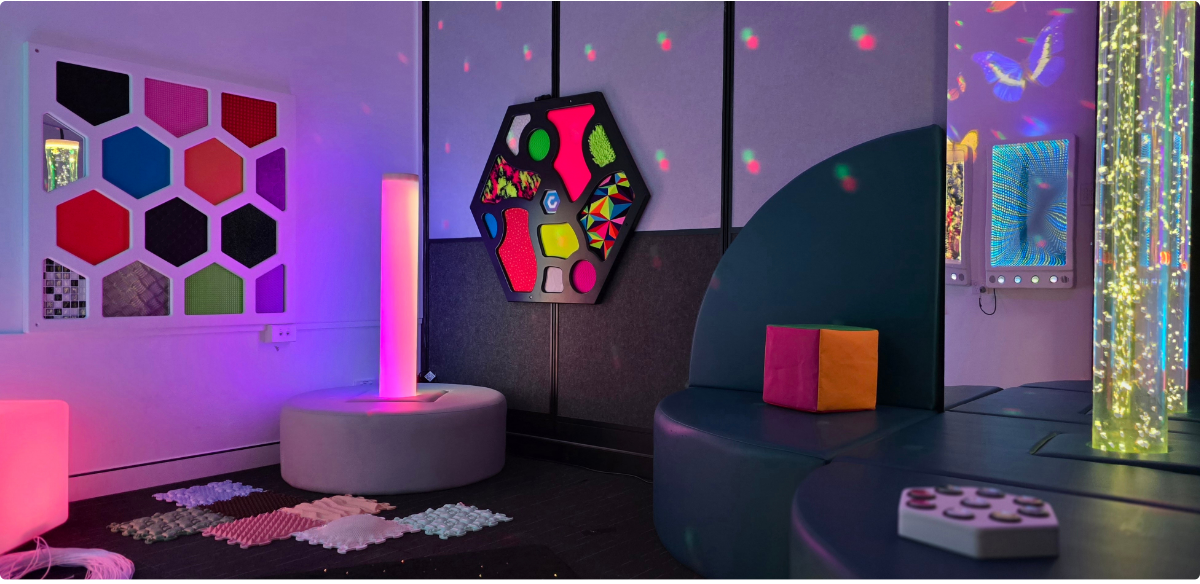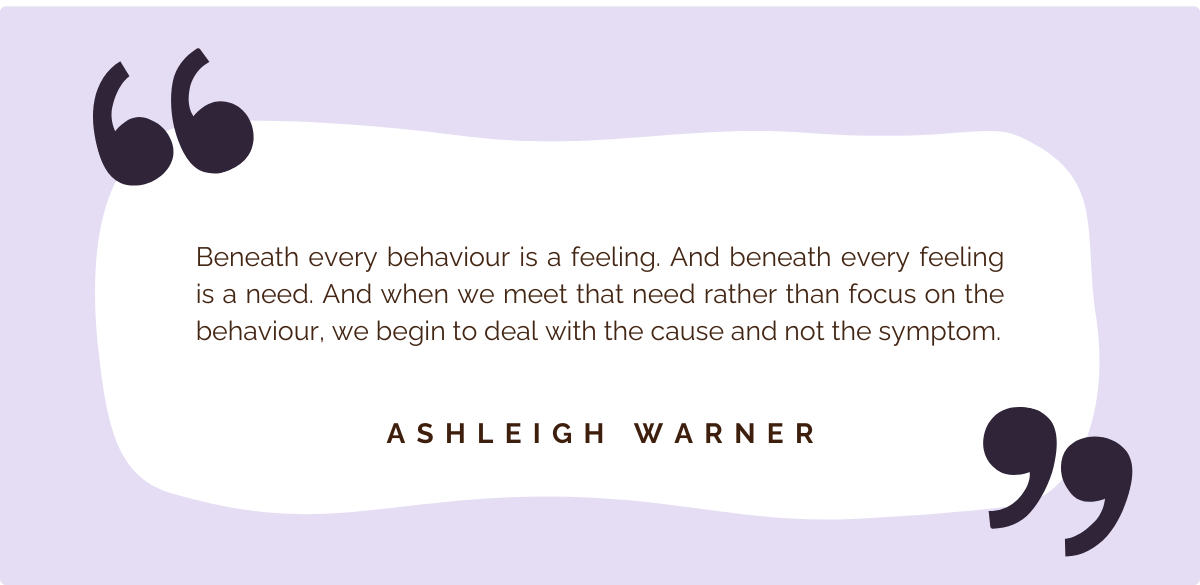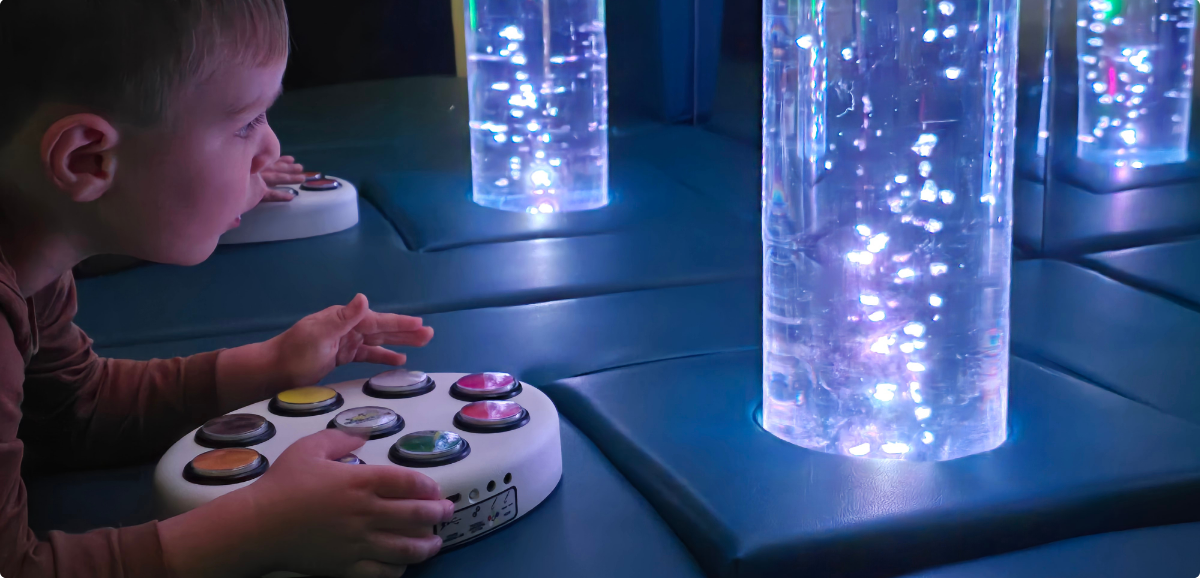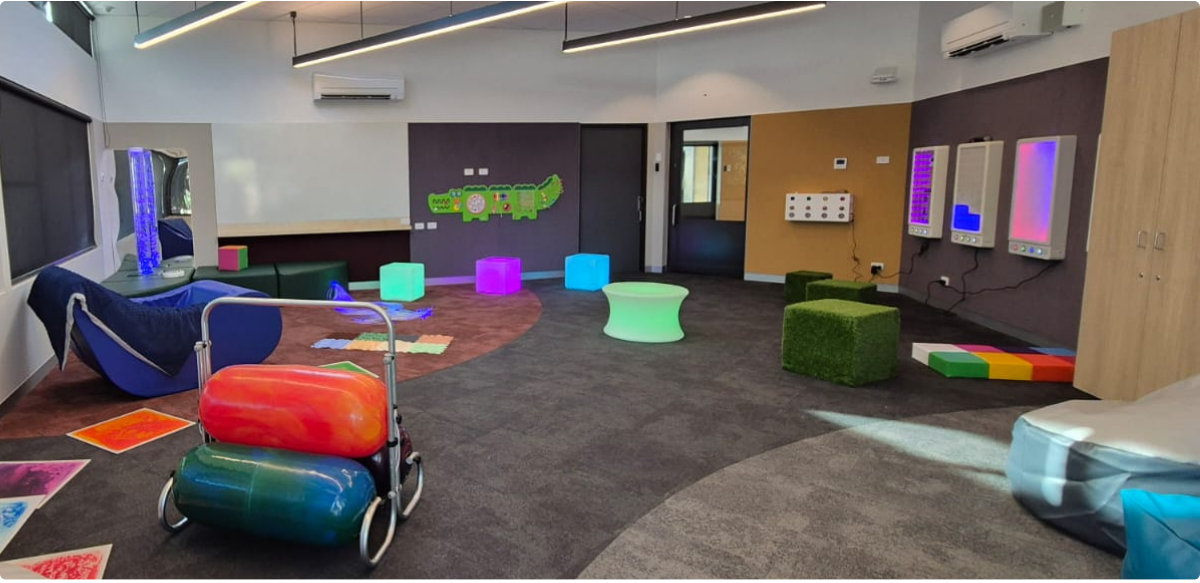Let’s dive into how to provide sensory support for ADHD. But first, what is a sensory space?
Essentially, it’s an intentionally designed area that provides sensory input to support self-regulation, focus, and stress relief. And while we can all benefit from such a space, it’s a fantastic way to help those with ADHD in their sensory processing, attention control, and hyperactivity.

Let’s break it down further…
HOW SENSORY SPACES SUPPORT THOSE WITH ADHD
To understand how sensory can help, we need to recognise the three main types of ADHD.
- ADHD Inattentive: characterised by difficulty focusing, forgetfulness, and trouble following instructions
- ADHD Hyperactive/ Impulsive: marked by restlessness, impulsivity, and difficulty staying still or waiting for turns.
- ADHD Combined (inattentive/ hyperactive/ impulsive): a mix of inattentive and hyperactive-impulsive behaviour.
Learn more about ADHD, the types of ADHD, and how it effects individuals here.
Of course with each type of ADHD comes different sensory needs, whether that be to stimulate or calm the senses, or a mixture of both. A well-designed sensory space usually combines a mix of stimuli, helping to:
Reduce sensory overload and anxiety
As ADHD often goes hand in hand with sensory processing difficulties, being able to control the amount and type of sensory stimulation prevents individuals from feeling overwhelmed and anxious.
Improve focus and attention
Certain types of sensory input, such as movement, visual stimulation, or deep pressure, can improve attention span and reduce distractions.
Support self-regulation and emotional intelligence
Sensory equipment provides an outlet and/or distraction for excess energy, heightened emotions, and impulsive behaviour.
Encourage movement for hyperactivity and restlessness
Movement-based stimulation such as active seating, swings, and soft play encourage movement and provide an outlet for hyperactivity and restlessness.
Prevent overstimulation
Soft lighting, weighted blankets, and quiet nooks create a calm and safe space for individuals to self-soothe and reset.

HOW TO CREATE AN ADHD-FRIENDLY SENSORY SPACE
- Location
First is location. Is it going to be a dedicated room or a corner? Or do you need portable sensory equipment?
- Sensory needs
As we have discussed, the type of ADHD will influence the sensory needs of an individual. Clarify– what are the main goals of the space? For example, do you want it to provide stimulation, relaxation, or both?
- Equipment & Resources
Considering the goals of your space, select the right mix of equipment and resources to support focus, self-regulation, and emotional well-being.
- Zoning
Next divide your chosen equipment into zones to meet different needs:
-
- Calm/ low-stimulation e.g. soft seating, deep-pressure input, vibrating equipment, dim lighting, quiet nooks
- Interactive/ mid-stim e.g. interactive wall panels, tactile panels, lighting and projection
- Movement/ high-stim e.g. swings, balance beams, soft play
By zoning your space this way, you should be able to identify any gaps in the sensory space – is there too much visual stimulation? Or perhaps you need to add more high-energy/ interactive items.
- Flexibility
Sensory spaces often need to accommodate various learning styles and sensory needs. Ensuring your chosen equipment can adapt to multiple users keeps the space effective and relevant. For example, Sensotec’s range of interactive wall panels– you can adjust each panel’s sound, brightness, speed, and volume.
- Training
And of course, training is essential to getting the most out of your sensory space. This includes an understanding of how to use the space effectively, how to recognise signs of sensory overload, how to select the appropriate sensory tools, and how to adjust the environment to suit different needs.

RECOMMENDED SENSORY TOOLS TO IMPROVE FOCUS AND CALM
Here’s our top picks to provide sensory support for ADHD- create a space that channels energy into focus and fun!
Bubbles
If you’re after a mesmerising multisensory experience, bubbles have you covered. By offering a great mix of visual, auditory and tactile stimulation, bubbles help to:
- provide a calming focal point to improve focus and concentration
- help regulate emotions with the rhythmic sound, soothing vibrations, and changing colours
- improve skills such as visual tracking and colour recognition
We recommend pairing with a colour controller (see these in action here), or adding artificial fish/ balls for extra engagement and fun. Plus, there are so many ways to use bubbles – in a bubble tube, a wall-mounted panel, or even on a portable sensory trolley.
Tactile Wall Panels
Particularly for those with hyperactive or combined ADHD, a craving for constant engagement may display in restless energy and fidgeting. Tactile wall panels are an excellent way to direct this energy into hands-on stimulation.
For example, sensory equipment like the Hex UV Tactile Panel and Crocodile Activity Panel improve sensory processing, boost motor, cognitive and communication skills, and improve focus. Check out our full range of interactive wall panels here.
Electronic Wall Panels
Another kind of wall panel – our range of electronic panels include adjustable sound, speed, brightness and volume to accommodate multiple users and prevent sensory overload. Their multisensory input is ideal for keeping the brain engaged for sustained focus and concentration. These panels can also help to:
- improve breathing, communication and speech
- develop skills like tracking and colour recognition
- reduce stress and anxiety
Check out these panels in action – so many ways to keep the hands busy and the mind engaged!

Active Seating and Soft Play
Another great outlet for excess energy – active seating like this Balance Stool and soft play equipment improve focus and engagement. Whether wobbling, jumping, bouncing, or balancing, soft play is a fun yet safe way to:
- improve postural stability and balance
- boost reflex response and flexibility
- develop motor planning and body awareness
- build confidence and inspire imaginative play
Of course, soft play doesn’t have to be high energy. For example, items like this Barrel and Bolster can also be used to gently rock back and forth- a rhythmic motion that can soothe the nervous system and improve focus.
Deep Pressure Input
Like a warm hug for the nervous system, deep pressure input from tools like weighted blankets, or a Squeeze Machine is a great way to help those with ADHD feel grounded and calm. More specifically, this deep pressure input helps activate the parasympathetic nervous system (let’s just call it the body’s “chill mode”), which in turn helps:
- reduce restless energy
- improve self-regulation
- boost focus
For those with ADHD, physical touch can be uncomfortable and stressful. In contrast, a consistent soothing pressure is a great way to improve spatial awareness and reduce anxiety without triggering sensory overload.

Keep in mind, these products are simply recommendations. However incorporating sensory equipment like the above into daily routines can make a world of difference.
Remember there is no ‘one’ way ADHD presents, it is highly individual. Similarly, each person has unique sensory needs, which is why tailored sensory support for ADHD is so important.
On the positive side, government programs, the National Disability Insurance Scheme (NDIS), and community organisations are continuing to recognise the growing importance of sensory spaces and the part they play in helping individuals with ADHD to self-regulate, learn and thrive.
At Sensotec, we work with you to maximise available funding and create custom sensory solutions to meet your space, budget, and goals. Additionally, we can guide you through the entire process from a discovery session to design, delivery, and installation.
Looking to explore your sensory options? Check out our full sensory product range or reach out for a chat here.